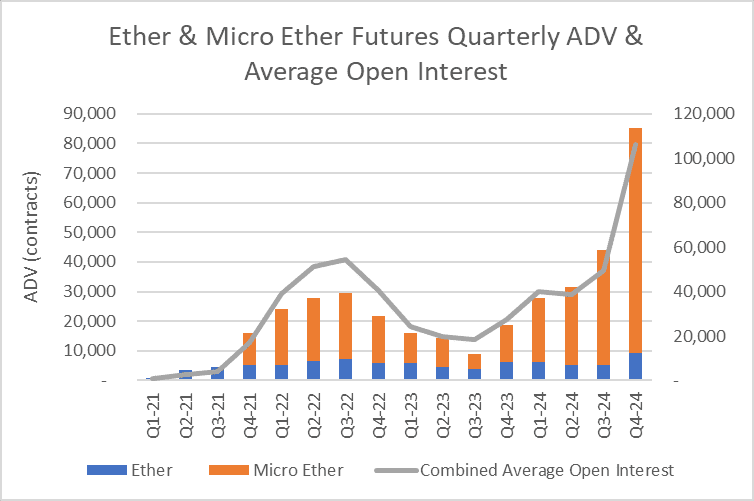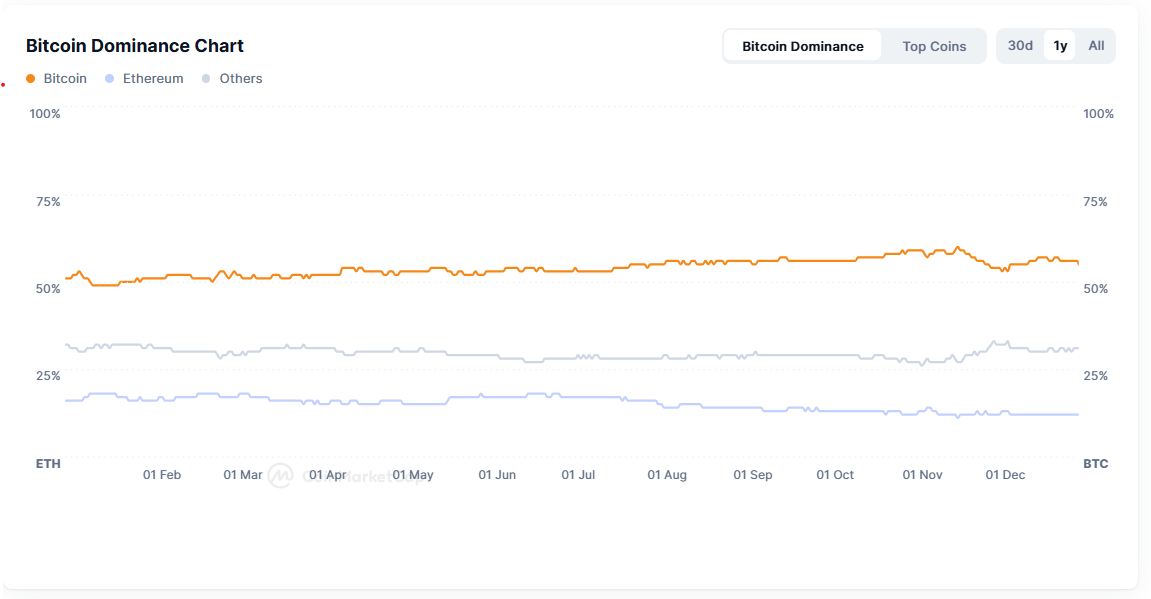Uncategorized
Why Ether Could Outperform Bitcoin in 2025

Ether spent most of 2024 trailing behind its cryptocurrency peers but has now firmly joined the rally sparked by bitcoin’s record-breaking climb, crossing the $4,000 mark in December but well below its all time high of $4,900.
In 2024, ether gained around 53% compared to bitcoin’s 113% surge; however, ether’s recent performance shows promise. Since the U.S. election result, ether has increased 39%, outperforming bitcoin’s 35% gain and signaling a potential resurgence driven by market optimism over president-elect Donald Trump’s anticipated pro-crypto policies.

Other key factors driving this optimism include robust staking dynamics, steady transaction fees and growing institutional interest, particularly through ETFs.
Ether futures
While the year started with muted volume, CME ether futures were the go-to product for risk management as spot ether ETFs began trading mid-year and volatility returned to the market toward year-end. In 2024, nearly 12 million contracts representing a total value of $256 billion traded between ether and micro ether futures. Thirty-nine percent of notional volume traded was transacted in Q4 2024 as the crypto markets reacted to the U.S. election results, signaling a buoyant sentiment.

Large open interest holders (designated by the CFTC as entities holding 25 or more contracts) reached new weekly records throughout December, indicating growing client interest in regulated solutions to manage ether risk.
Ether-bitcoin ratio
The ETH-BTC ratio, which measures ether’s performance relative to bitcoin and shows the number of bitcoin needed to buy one ether, reached its lowest level since launch on Nov 20 of 0.032857, which may be its bottom as we see improved regulatory outlook and an increase in institutional adoption.

What’s behind ether’s rebound
1. Ether ETFs outperform bitcoin ETFs
U.S. spot ETH ETFs have received a cumulative $577 million in net inflows since their July 2024 launch, an overall success among the broad ETF universe. Between November 25 and November 29, spot ether ETFs even surpassed the daily inflows of bitcoin ETFs, with ether ETFs experiencing a net inflow of $467 million (including net inflows of $428 million in a single day), marking a shift in investor sentiment.
The approval of both bitcoin and ether ETFs represents a major milestone in the mainstream adoption of digital assets. Looking ahead, the interest of institutional investors could rise even further if regulatory approval allows asset managers to incorporate Ethereum staking yields into ETFs.
2. Alt Season
After months of ether underperforming bitcoin, traders may now see the ETH/BTC ratio’s lower level as an opportunity with a potential gradual rotation from BTC to ETH and other alt coins.
Typically, bitcoin leads the rally, then consolidates as ether and other alt coins catch up. This has been true this cycle where bitcoin’s dominance dropped from 61.7% in October to 57.4% in November and to 56.5% in December, suggesting that altcoins may have begun gaining momentum for a potential alt season.

3. Staking yields
Ether investors can generate extra returns on top of their holdings by staking or locking their coins in the network in return for rewards. As of the time of writing, 28% of ether’s supply is locked in staking contracts with the annualized reward rate averaging 3%. Under a new administration, together with anticipated Federal Reserve interest rate cuts and continued upgrades to the blockchain, there could be an uptick in ETH’s staking yield.
4. DeFi, smart contracts, DAPPS and NFTs
Ethereum’s value proposition extends beyond being a digital currency, as it remains the dominant blockchain for building decentralized finance (DeFi) applications (DAPPS), smart contract platforms, NFT (non-fungible token) tokenized assets and Web3 applications.
The total value locked (TVL) in Ethereum-based DeFi projects has grown over the past few weeks, reaching $69.4 billion, according to DefiLlama. The surge suggests rising confidence in Ethereum as a platform for financial innovation.
5. Ether upgrades
On March 24, Ethereum implemented the Dencun upgrade, which reduced transaction costs for Layer 2’s and increased the Transactions per Second (TPS) at which they could post to the Layer 1. The adoption of Layer 2’s has shifted noticeably over the last year. In addition, the Pectra upgrade, expected in Q1 2025, is one of the largest hard forks ever in terms of the Ethereum Improvement Proposal (EIP) count. It aims to improve protocol efficiency, enhance the user experience and expand data capacity, as well as pave the way for future scalability enhancements.
Conclusion
All eyes are on what the Trump administration will bring and the implications for the entire crypto market. The growing interest of institutions in ether ETFs could signify a diversification of institutional portfolios, which were once largely focused on bitcoin. The possibility of staking rewards and ether’s central role in DeFi and NFT innovations in 2025 may bring even more demand for ether.
Uncategorized
Elon Musk vs. the regulators
Welcome back to TechCrunch Mobility, your hub for all things “future of transportation.”
Uncategorized
Nvidia’s AI empire: A look at its top startup investments
Over the last two years, Nvidia has used its ballooning fortunes to invest in over 100 AI startups. Here are the giant semiconductor’s largest investments.
Uncategorized
Dating app Cerca will show how Gen Z really dates at TechCrunch Disrupt 2025
Cerca is a dating app that sets users up with mutual friends.
-

 Business12 месяцев ago
Business12 месяцев ago3 Ways to make your business presentation more relatable
-

 Fashion12 месяцев ago
Fashion12 месяцев agoAccording to Dior Couture, this taboo fashion accessory is back
-

 Entertainment12 месяцев ago
Entertainment12 месяцев ago10 Artists who retired from music and made a comeback
-

 Entertainment12 месяцев ago
Entertainment12 месяцев ago\’Better Call Saul\’ has been renewed for a fourth season
-

 Entertainment12 месяцев ago
Entertainment12 месяцев agoNew Season 8 Walking Dead trailer flashes forward in time
-

 Business12 месяцев ago
Business12 месяцев ago15 Habits that could be hurting your business relationships
-

 Entertainment12 месяцев ago
Entertainment12 месяцев agoMeet Superman\’s grandfather in new trailer for Krypton
-

 Entertainment12 месяцев ago
Entertainment12 месяцев agoDisney\’s live-action Aladdin finally finds its stars


